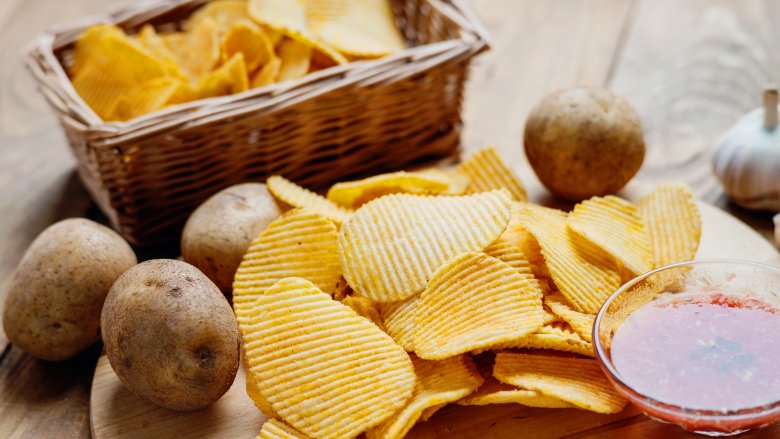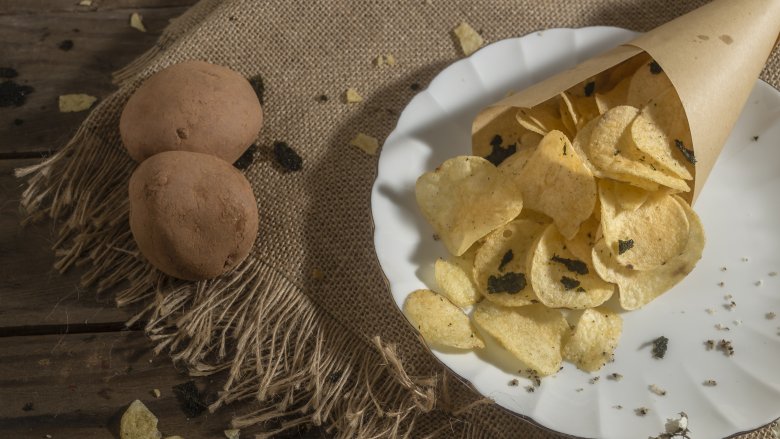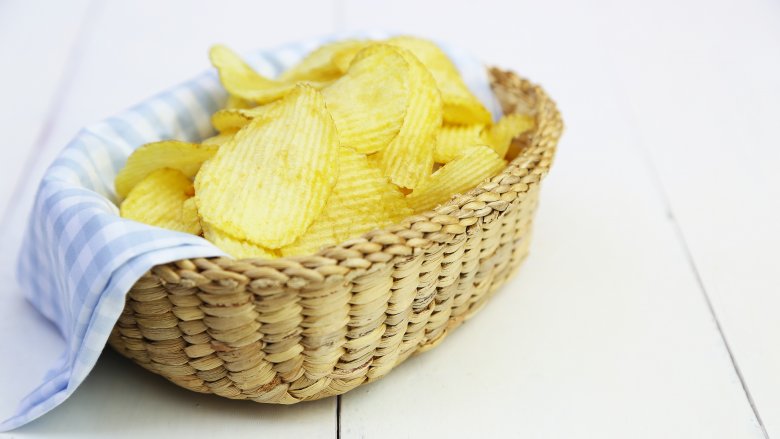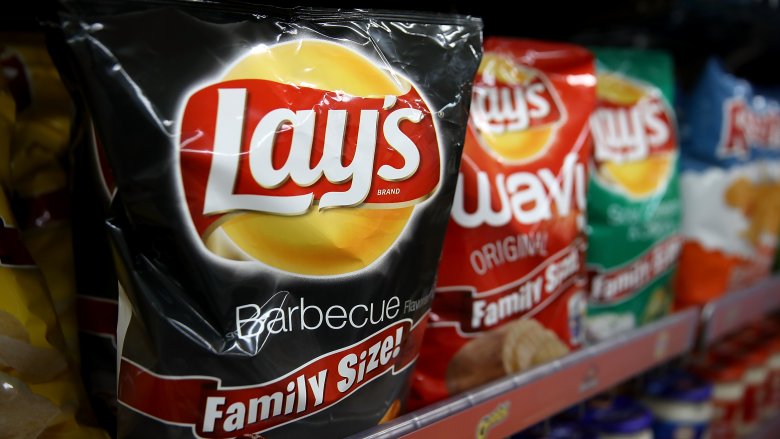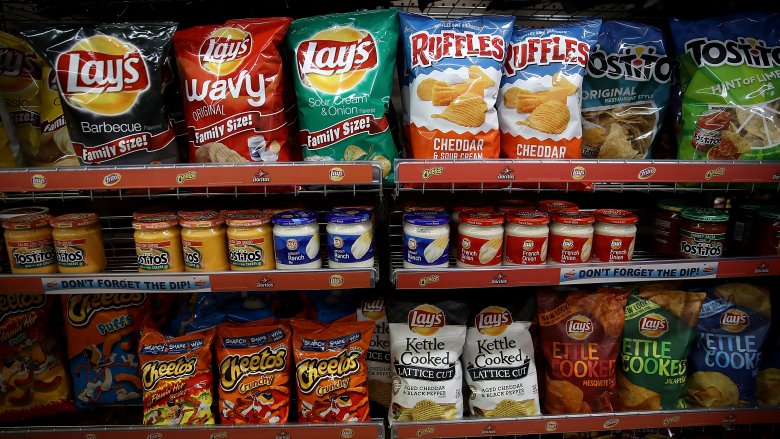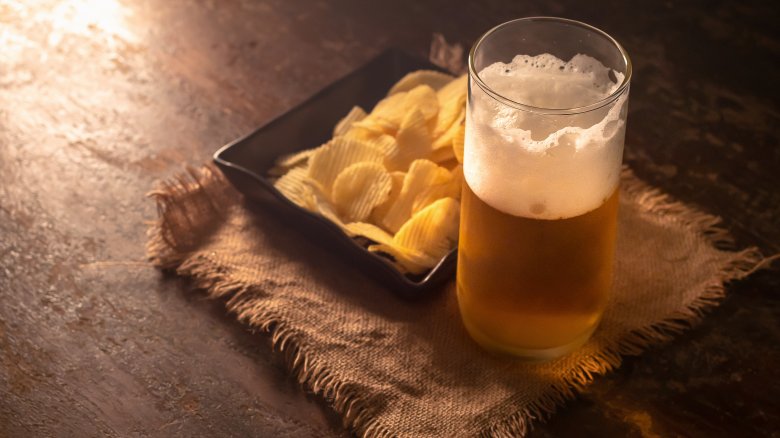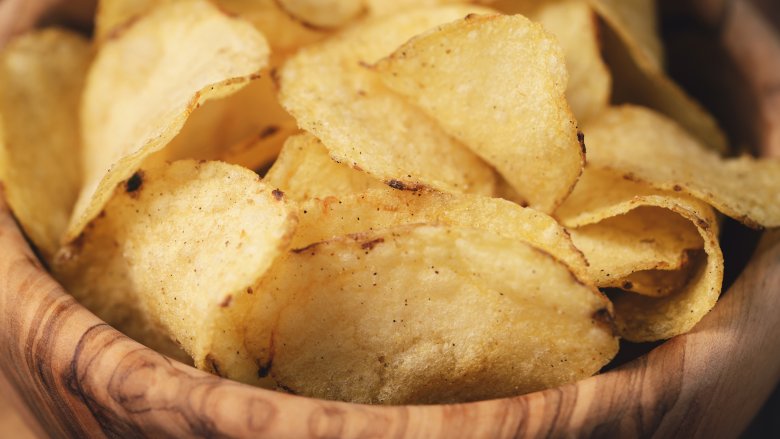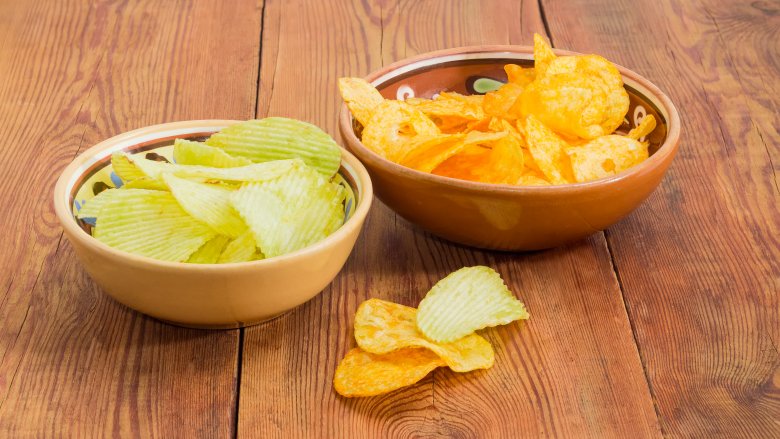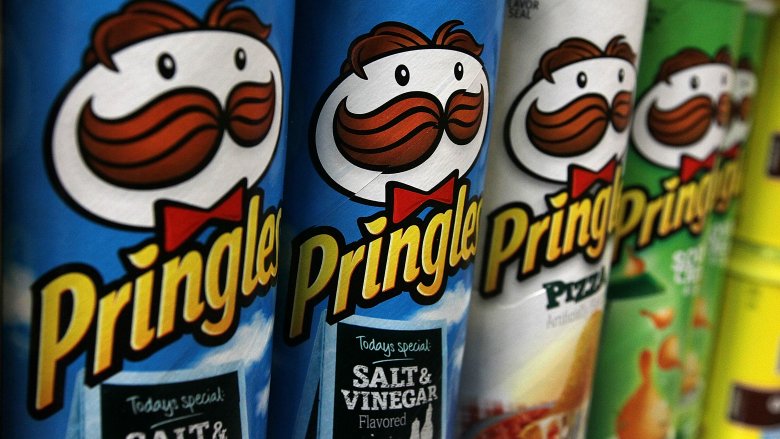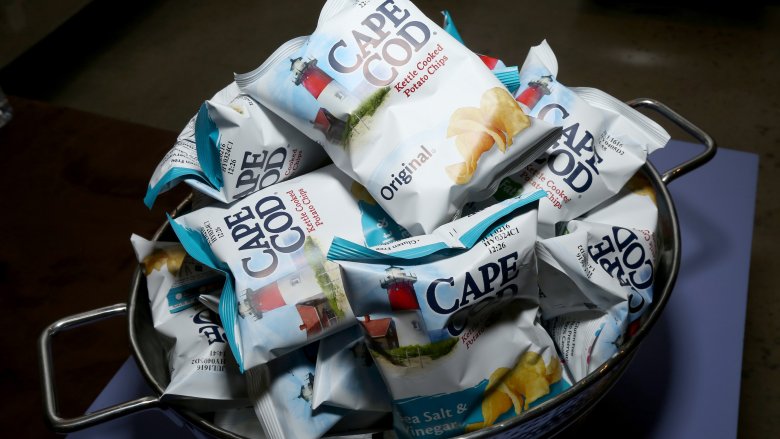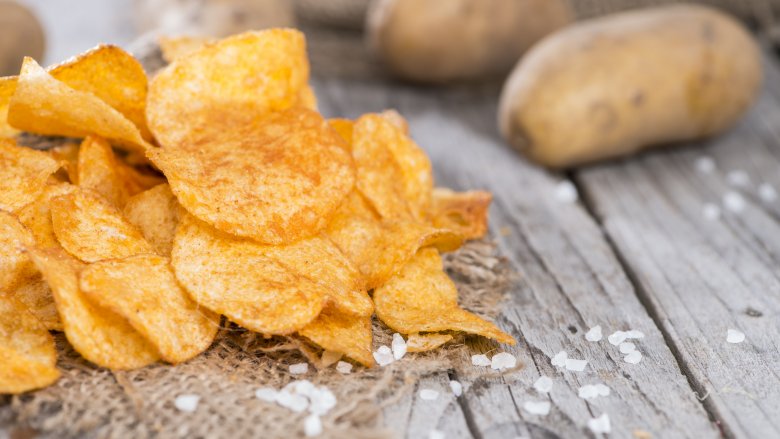The Strange History Of Potato Chips
It doesn't matter whether you call them chips or crisps, they're one of the most popular snack foods in the world. How popular? According to the Northern Plains Potato Growers Association, the average American eats around four pounds of them each and every year, and in 2011, that added up to 1.5 billion pounds of potato chips. Time Money says around 11.2 million pounds of chips are eaten on Super Bowl Sunday alone, and that's an almost unthinkable amount of chips.
It's not just America who loves their chips, there are a shocking variety of flavors found all over the world. Do some traveling, and you'll find chili and chocolate chips, baked bacon and cheese with seaweed, blueberry, brie and cranberry, and even cajun squirrel flavored chips (via Food Network). The entire world loves them, but we're betting very few people actually know their strange story. Potato chips have an incredibly weird history involving everything from Prohibition-era gangsters to racism and rumors of secret benefits best experienced in the bedroom. Strange? That's just the start.
The potato chip's origin story is a myth
The popular tale of the invention of the potato chip is that in 1853, New York chef George Crum served up a meal for Cornelius Vanderbilt, who sent it back to the kitchen because the fries were too thick. In response, Crum fried up some super-thin potato shavings and sent those back out, because some people just don't like criticism. The chips were a hit, and the world's snacking habits changed forever.
Or, were they?
Not so fast, says JSTOR Daily. As great a story as it may be, none of it's true. They start with the fact Vanderbilt wasn't even in the US at the time the incident supposedly happened, and add that newspaper clippings from 1849 sang the praises of a cook named Eliza, who had a major reputation for her "potato frying" prowess. The first time the story about Crum ever showed up was in 1885, and Vanderbilt wasn't even included in the story until more than a hundred years later. Historians have no idea what the real story is, but suspect it's more accurate to say Crum helped popularize it, instead of inventing it. So where did it come from?
They may have started as health food
Quite Interesting took a shot at tracking down the real origin of the potato chip, and according to what they found, Americans should probably be calling them "crisps" instead. While Crum's claim to fame came in the late 19th century, British physician William Kitchiner, MD, wrote The Cook's Oracle in 1822. It was released in the US in 1829, and it contained a recipe for "Potatoes fried in Slices or Shavings".
The book called for the potatoes to be peeled then sliced or shaved as if "you would peel a lemon." The shavings — or quarter inch thick slices — were then to be fried "in lard or dripping," and once they were crisp, they should be left to cool and sprinkled with salt. It certainly sounds familiar, so who was this Kitchiner fellow?
According to the book's preface, he was a doctor most concerned with food preparation. He had noticed that many people paid more attention to the quality of their animals' food over their own, and he assembled the book to teach people proper nutrition. There you have it — potato chips are a Victorian-era health food.
They were never patented
Even though he didn't invent the potato chip, George Crum can still be given kudos for making them popular. He was the first one to put potato chips on the culinary map, as it were, and according to the Massachusetts Institute of Technology, Crum's potato chips were insanely popular, and they were called "Saratoga Chips." When Crum opened his own restaurant, Crumbs House, one of the things that made it ridiculously popular was the basket of chips he put on each table.
You'd think he would have done something to capitalize on the popularity of the chip, but Crum never even attempted to patent what was, for most purposes, his trademark creation. That's because no amount of culinary genius would allow Crum to even apply for a patent. The son of a black father and a Native American mother, Fox News says Crum simply wasn't allowed to apply for a patent. That was a right minorities didn't enjoy, and it's also why potato chips were replicated and sold without Crum getting, well, any crumbs.
Lay's as an aphrodisiac
Lay's potato chips are one of the most popular brands in the US, and if you're of a certain age (about 11) and mindset, you might think the name "Lay's" is a little risque and pretty hilarious. Strangely, you wouldn't be entirely wrong.
According to Snopes, Herman Lay was one of the first people to make potato chips into a commercial endeavor. He started in the American Southeast, and his product got a major boost in popularity thanks to a bizarre claim. Whispered rumors claimed the chips had a certain aphrodisiac quality, and that's not the kind of rumor an enterprising salesman would try to squash.
The belief in potato's mystical, magical nature went back a long way, at least, says the Smithsonian, to 18th century Europe. It was thought to be an aphrodisiac and to have the power to cure leprosy, which might be the strangest combination of superpowers yet.
The bag's a big deal
It seems pretty logical today: potato chips come in bags. But for decades, people ate their potato chips from baskets, barrels, or tins, and that's a lot of work for everyone. It wasn't until Laura Clough Scudder introduced the idea of packaging chips in bags that the potential to mass-market them on a commercial scale was really possible.
According to Chips & Crisps, Scudder was mainly concerned with keeping her chips fresher. She tasked her employees with some after-hours work, giving them sheets of wax paper and asking them to spend the evening ironing them together to form bags they would fill and seal the next day. Her company was founded in 1926, and those bags were one of the first things she added to the potato chip process. Brilliant, right?
Scudder also made her company's name based on freshness, and in order to guarantee that freshness, she also introduced something else to the potato chip world: dates on the bags.
Al Capone loved them
Most early potato chip recipes called for frying the potatoes in lard, and lard is one of those words that just doesn't even sound appetizing. Today, we use oil to fry chip in, and the change came in a super strange way.
It was 1927 when one-time prizefighter Leonard Japp decided to make his living in a little less physically punishing way, and turned to snack foods. He's the first one who switched to frying potato chips in oil, and the company was a massive hit thanks mostly to one large client: Al Capone.
According to South Side Weekly, Capone had already sampled potato chips in New York, and ever the enterprising businessman, he realized they would be perfect for his Prohibition-era speakeasies. Japp — who originally started selling chips on the street — climbed the ladder of success, opened factories to produce the number of chips Capone needed, and his oil-fried chips became hugely popular. Unfortunately, anti-Japanese sentiment surrounding World War II necessitated a name change, and Japp's became Jay's. And according to his 2000 obituary in the Chicago Tribune, it all started with an initial business investment of $27.50, and it changed the way we make chips.
WWII made them even bigger
World War II changed a lot of things, and that includes potato chips. According to Food and Drink in American History, they were originally declared to be a "nonessential food", which meant all potato chip production needed to cease until the end of the war. By this time, there were enough manufacturers that they had the clout to successfully lobby for the change in designation, and getting it overturned was one of the best things that could have happened to the potato chip industry for a few reasons.
First, sugar was rationed and the availability of sweet, feel-good treats was at a low. People turned to potato chips to satisfy their snack cravings, and sales skyrocketed on the homefront.
Abroad, troops were being sustained by chips, too. According to The Telegraph, they were already firmly entrenched in British culture, and entire troop ships packed with chips (or, more accurately, crisps) were shuttled off to deliver their crunchy goodness to Allied troops all over the world.
They weren't flavored for a long time
Flavored potato chips aren't just a given, they can be downright bizarre. Bored Panda counts wasabi ginger, butter garlic scallop, and white chocolate peppermint among the strangest they've ever found, and that's just scratching the surface. Pretty much anything and everything has been put on a potato chip, but before the 1950s, it was plain or nothing. Customers even had to add the salt themselves, and the Huffington Post says that next time you dig into a bag of cappuccino flavored chips, you should thank Ireland's Joe "Spud" Murphy.
Murphy founded Tayto in 1954, which is kind of surprising, considering how much he disliked plain chips. He called them "insipid," and set out to develop a manufacturing process that would allow them to flavor chips. He — and employee Seamus Burke, adds Quite Interesting — did, and when they released their very first flavored chip, the snack world didn't look back.
Tayto's first flavors are still the most popular today: Cheese and Onion, then Salt and Vinegar. Here in the US, the first flavors released were different but no less popular: Sour Cream and Onion, and Barbecue.
Pringles are a mystery
First, what's in a name? There are two different stories about just where "Pringles" came from, and The Atlantic says one oft-told tales is that two of the advertising agents involved in early marketing lived on Cincinnati's Pringle Drive. There's another theory, though, and that's the possibility they were named for Mark Pringle, an inventor who spent a good deal of time trying to create a manufacturing process that would yield regularly-shaped potato chips.
That's not the only debate over Pringles — there's also the idea they're not technically potato chips — at least not according to a 1975 ruling by the FDA, notes Food & Wine. Since they're made with a different process, they're required to be labeled as "potato chips made from dried potatoes," and there's one more strange footnote to Pringles history. Maybe that's why when they first came out, Pringles were actually a dismal failure. It wasn't until a 1980 revamp in marketing that the public was willing to accept these suspiciously uniform chips, and the rest is history.
A car crash saved Cape Cod Potato Chips
Sure, Lay's are great, but sometimes you're in the mood for something a little different. Cape Cod Potato Chips are definitely that, and their kettle cooked chips were a local favorite for a reason. They almost didn't happen, though.
Founded in 1980 by Steve Bernard, there were problems from the beginning — including some hate from the woman who owned the house just visible in their original logo. When Bernard heard about it, business was so tough that he told the Chicago Tribune, "I thought, 'Lady, if you want this business, it's yours.'"
The lowest point was the day a car crashed through the front window of their Hyannis store. His wife and daughter were in the building, narrowly escaping tragedy because they'd chosen the seconds before the crash to head into the back. At the time, they were working with their last load of potatoes, until the insurance money took some of the financial pressure off, and the coverage in the local paper gave them the publicity they needed to survive.
Why Pennsylvania?
When Atlas Obscura found out Hanover, Pennsylvania was at the epicenter of a handful of counties that made up the country's biggest hub of snack food and potato chip production, they did some digging to try to figure out what it was that made this unlikely area so important.
They found something of a sort of perfect storm for snack foods: German immigrants brought pretzels, chocolate was connected to Philadelphia's ports, sugar, and the slave trade, and there's something special about their potatoes, too. The area has a humid climate that, coupled with soil that's just the right amount of acidic, makes perfect potato chip potatoes.
Some of the oldest potato chip companies in the world are in this little potato paradise, and chances are pretty good that if you live outside of PA, you may have never had Bickel's, Middleswarth, Hartley's, or Gibbles. But you can still pick up some chips made here: Wise, Utz, and Herr's all come from this piece of Pennsylvania, and some of their chips are still made in much the same way they were more than a century ago.
They're actually designed so you can't eat just one
There have been a ton of snack foods that have sort of fallen off the world's radar, so what makes potato chips so enduring? There's actually a strange bit of psychology behind it all, and in 2013, researchers presented some findings at the National Meeting & Exposition of the American Chemical Society (via Psychology Matters). The study was on a phenomenon called hedonic hyperphagia, and it's basically the idea that people eat because it feels good, not because they actually need to.
Potato chips are pretty much the poster child for this condition, and researchers say that's because chips have the perfect combination of fat, carbs, and some other still-mysterious component that directly impacts the pleasure centers in the brain. Psychology Today says the addictive quality of potato chips also has something to do with their sodium content, and as if that's not enough, Audio Burst found that those crinkly bags potato chips come in have been designed that way on purpose. It's all about triggering a sensory experience, and that ultimately makes us eat more because we enjoy the chips more. Now you know.
